Damper installation in liner?
- Thread starter John B
- Start date
-
Active since 1995, Hearth.com is THE place on the internet for free information and advice about wood stoves, pellet stoves and other energy saving equipment.
We strive to provide opinions, articles, discussions and history related to Hearth Products and in a more general sense, energy issues.
We promote the EFFICIENT, RESPONSIBLE, CLEAN and SAFE use of all fuels, whether renewable or fossil.
You are using an out of date browser. It may not display this or other websites correctly.
You should upgrade or use an alternative browser.
You should upgrade or use an alternative browser.
6" x 6" stainless here
https://www.rockfordchimneysupply.c.../304l-stainless-steel-rigid-chimney-liner.php
https://www.rockfordchimneysupply.c.../304l-stainless-steel-rigid-chimney-liner.php
Do
sorry Bholler I just saw that you already answered my question above ( I misread and thought your answer to the op was just it can’t be done in flex pipe ) but you later answered you use single wall Ss and I gues make the MPD
Easy Livin’ 3000
Minister of Fire
I'm considering putting a piece of ceramic wool above the baffle to reduce the space between baffle and stovetop. Don't know if it'll help, but it's cheap enough to try it. Still need to measure the space, but I'm thinking 1" thick wool might be worth a try.
I'd like to install a damper, too, but it would definitely complicate sweeping from the bottom up like I do.
I'd like to install a damper, too, but it would definitely complicate sweeping from the bottom up like I do.
chazcarr
Minister of Fire
I'm considering putting a piece of ceramic wool above the baffle to reduce the space between baffle and stovetop. Don't know if it'll help, but it's cheap enough to try it. Still need to measure the space, but I'm thinking 1" thick wool might be worth a try.
I'd like to install a damper, too, but it would definitely complicate sweeping from the bottom up like I do.
Can you expand on this? I am having a hard time picturing this. Like stuffing the area behind the cat with steel wool?
mellow
Resident Stove Connoisseur
If I wanted to slow down a draft on an insert with flex liner this is what I would do:
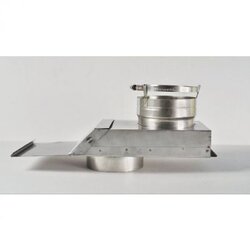
- Block incoming air via magnet (removable)
- Try a different chimney cap or reduce current one
- Install an off-set box

Last edited by a moderator:
HomeinPA
Minister of Fire
I don't think that's his question. I think he means if one would do insert a piece of rigid and then install a stovepipe damper as you suggested, would that or would it not void the UL listings of either appliance since neither was tested with said damper modification?Like I said you can't put a damper in a liner.
I would think the liner would be ok since freestanding stoves can have stovepipe dampers and that has no impact. The insert itself may be another issue.
If the insert says don't use a damper it would void the ul listing if it doesn't say that I don't see a problem. And the excessive draft would be much more of a problemI don't think that's his question. I think he means if one would do insert a piece of rigid and then install a stovepipe damper as you suggested, would that or would it not void the UL listings of either appliance since neither was tested with said damper modification?
I would think the liner would be ok since freestanding stoves can have stovepipe dampers and that has no impact. The insert itself may be another issue.
Easy Livin’ 3000
Minister of Fire
There is a space above the baffle on most tube stoves that the air passes over before exiting into the stove pipe. On an earlier model of my stove, the ceramic blankets was a standard part- 1/2" thick, 12" wide, 16" long. It laid flat on top of the baffle, weighed down with a steel disk, and I think it was there to reduce emissions.Can you expand on this? I am having a hard time picturing this. Like stuffing the area behind the cat with steel wool?
I don'f think stuffing steel wool in my flue would be a good idea.
A cat stove has a different set-up, so I don't know that my ceramic blanket idea has any applicability.
HomeinPA
Minister of Fire
I always thought the ceramic wool was to help keep the heat reflected back towards the fire and/or insulate the baffle.There is a space above the baffle on most tube stoves that the air passes over before exiting into the stove pipe. On an earlier model of my stove, the ceramic blankets was a standard part- 1/2" thick, 12" wide, 16" long. It laid flat on top of the baffle, weighed down with a steel disk, and I think it was there to reduce emissions.
I don'f think stuffing steel wool in my flue would be a good idea.
A cat stove has a different set-up, so I don't know that my ceramic blanket idea has any applicability.
Easy Livin’ 3000
Minister of Fire
That's what they are for- hotter fire=lower emmissions. Most are 1/2" thick, apparently.I always thought the ceramic wool was to help keep the heat reflected back towards the fire and/or insulate the baffle.
But, I'd imagine, if the space is 2", and you added 1" of wool on top of the baffle, the flow might slow down a little. That's my idea. Only way I'll find out is to try.
weatherguy
Minister of Fire
Those are a nightmare when it comes to cleaning, I guess it would slow the draft a bit.If I wanted to slow down a draft on an insert with flex liner this is what I would do:
https://www.rockfordchimneysupply.com/chimney-liners/adapters-accessories/off-set-box.php
- Block incoming air via magnet (removable)
- Try a different chimney cap or reduce current one
- Install an off-set box
View attachment 238376
Easy Livin’ 3000
Minister of Fire
I explored the offset box idea in a thread a couple months back, which would have solved two problems. Our favorite chimney sweep pointed out correctly that it rules out bottom up sweeping. And trust me, compared to an ashy blanket, climbing on my roof is a way bigger nightmare.Those are a nightmare when it comes to cleaning, I guess it would slow the draft a bit.
I also tried the magnet bit. Didn't solve the problem, but I'm not done experimenting with that.
I'm against the idea of a chimney cap solution. Only creasote buildup I get is on the cap, and im not climbing on that roof to clean one that restricts flow and slowly closes in with creosote.
I've been splitting larger, which has helped quite a bit, plus the wood isn't as dry as past years because of all the rain and humidity last year. No "Gates of hell" situations this year.
The blanket is around $20, I can get to it from terra firma, cap stays clean, and I can keep bottom up sweeping. Meets all my criteria. But, will it work? Only one way to find out.
mellow
Resident Stove Connoisseur
When it comes to cleaning you drop the front and vacuum out what falls down, you will have to do a top down cleaning. I normally do not recommend them as they hurt the draft but in an overdraft situation they are potentially useful.
The offset box would actually make my life easier for cleaning.
My roof is easily accessible so I dont mind a top down cleaning. The stove runs very clean and so far I have inspected the chimney a few times and it has not needed a cleaning yet, so Im thinking I may be good once a year. Right now they way the insert is setup to clean it I would have to reach inside and around the back up the stove to vacuum as there is a shelf where the cat sits that all the ash/creosote would land on during a cleaning. With the offset box, it has a cleanout door so I can actually get in there easier to vacuum it out. I may also be able to add a damper in there as well. Seems like a win.
My roof is easily accessible so I dont mind a top down cleaning. The stove runs very clean and so far I have inspected the chimney a few times and it has not needed a cleaning yet, so Im thinking I may be good once a year. Right now they way the insert is setup to clean it I would have to reach inside and around the back up the stove to vacuum as there is a shelf where the cat sits that all the ash/creosote would land on during a cleaning. With the offset box, it has a cleanout door so I can actually get in there easier to vacuum it out. I may also be able to add a damper in there as well. Seems like a win.
Easy Livin’ 3000
Minister of Fire
Sounds like you have your solution!The offset box would actually make my life easier for cleaning.
My roof is easily accessible so I dont mind a top down cleaning. The stove runs very clean and so far I have inspected the chimney a few times and it has not needed a cleaning yet, so Im thinking I may be good once a year. Right now they way the insert is setup to clean it I would have to reach inside and around the back up the stove to vacuum as there is a shelf where the cat sits that all the ash/creosote would land on during a cleaning. With the offset box, it has a cleanout door so I can actually get in there easier to vacuum it out. I may also be able to add a damper in there as well. Seems like a win.
If I ever get around to building the widows walk on my roof next to my chimney, I'd try the offset box, both for draft and to move my stove forward an inch or two. Top down cleaning would be fine then.
Let us know how it works out.
Figured I would update this thread. On Monday I ended up installing a damper. I havent finished the linkage system so for now we are running the stove without the surround but the linkage will be done on Saturday. Ill post a pic when done. I ended up using a 15 degree stainless elbow which fit perfect.
Wow, what a difference the damper has made for this installation. The heat output of the stove is unreal. I am finally seeing "ghost flames" in the box during a high cat burn and I'm easily getting 1150-1200 cat temps with everything turned down. At times before I was wondering where the heat was going, but now I know it was going out the flue! Our house is getting so warm now that we've started running it longer between loads. wish I had installed this damper when I did the inital setup but hey, its now and what a difference.
Thanks for all the advice in this thread. Really appreciate it.
Wow, what a difference the damper has made for this installation. The heat output of the stove is unreal. I am finally seeing "ghost flames" in the box during a high cat burn and I'm easily getting 1150-1200 cat temps with everything turned down. At times before I was wondering where the heat was going, but now I know it was going out the flue! Our house is getting so warm now that we've started running it longer between loads. wish I had installed this damper when I did the inital setup but hey, its now and what a difference.
Thanks for all the advice in this thread. Really appreciate it.
Woody Stover
Minister of Fire
Huh...can you explain, or link to a pic or diagram of this "damper" thing?I saw that the Ashford kind of has a damper right behind the catalyst, but it is rigid in place. You open the damper by opening the bypass. Controlling the air intake doesn't really work since the stove controls its own air intake.
If you slam the thermostat control way down, it will override the spring and not open, right?
I like the elbow solution. I would only use the offset box if I needed the stove out further..they seem kinda cheesily-constructed.I ended up using a 15 degree stainless elbow which fit perfect.
Wow, what a difference the damper has made for this installation. The heat output of the stove is unreal. I am finally seeing "ghost flames" in the box during a high cat burn and I'm easily getting 1150-1200 cat temps with everything turned down. At times before I was wondering where the heat was going, but now I know it was going out the flue! Our house is getting so warm now that we've started running it longer between loads. wish I had installed this damper when I did the inital setup but hey, its now and what a difference.
Yep, now you are seeing the benefit of slowing the exhaust stream down to where your stove can extract more heat. You might find that you can also get more heat while burning down coals.
I went ahead and put a damper in my tee snout but I don't use it. I've only got 16' of stack. I guess it wouldn't hurt to try it though. Can't believe I never did but I can crash the cat just using the air control so I never felt I needed to slow it down more..
Easy Livin’ 3000
Minister of Fire
Great news, well done on figuring this out.Figured I would update this thread. On Monday I ended up installing a damper. I havent finished the linkage system so for now we are running the stove without the surround but the linkage will be done on Saturday. Ill post a pic when done. I ended up using a 15 degree stainless elbow which fit perfect.
Wow, what a difference the damper has made for this installation. The heat output of the stove is unreal. I am finally seeing "ghost flames" in the box during a high cat burn and I'm easily getting 1150-1200 cat temps with everything turned down. At times before I was wondering where the heat was going, but now I know it was going out the flue! Our house is getting so warm now that we've started running it longer between loads. wish I had installed this damper when I did the inital setup but hey, its now and what a difference.
Thanks for all the advice in this thread. Really appreciate it.
Look forward to your pictures. I think it could help my situation too.
Easy Livin’ 3000
Minister of Fire
Figured I would update this thread. On Monday I ended up installing a damper. I havent finished the linkage system so for now we are running the stove without the surround but the linkage will be done on Saturday. Ill post a pic when done. I ended up using a 15 degree stainless elbow which fit perfect.
Wow, what a difference the damper has made for this installation. The heat output of the stove is unreal. I am finally seeing "ghost flames" in the box during a high cat burn and I'm easily getting 1150-1200 cat temps with everything turned down. At times before I was wondering where the heat was going, but now I know it was going out the flue! Our house is getting so warm now that we've started running it longer between loads. wish I had installed this damper when I did the inital setup but hey, its now and what a difference.
Thanks for all the advice in this thread. Really appreciate it.
Hey John- was there any issue with the chimney liner, where it slides into the elbow, getting in the way of the damper operation? I see they sell 5" dampers as well as 6" ones, but does the 6" one fit inside the liner without issue?
Also, about how far up on the elbow did you drill the holes for the damper pivot rod?
Thanks.
The liner for this chimney is 8". I installed the damper on the side of the elbow which connects to the stove, but there were no clearance issues with the liner itself as I tested that as well prior to install. The damper was installed just above the connection to the stove.
I installed the damper so the control handle faced the front of the stove. To extend the linkage, I welded some 1/4" threaded rod to the damper handle just long enough to extend about 1" past the surround. I drilled a 1/4" hole in the surround for the linkage to pass through. I used threaded rod so I can easily remove the handle to take off the surround. I welded it together so that I wouldnt have any issue with it falling apart (pardon my welding skills, they are not very good)
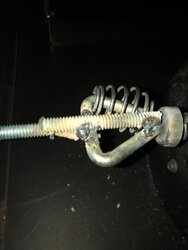
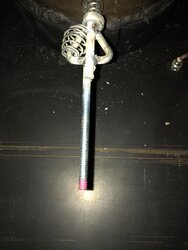
I had an extra 6" damper from some old pipe I removed from another stove, so I cut the end of the handle off and welded it to a threaded rod joining nut.
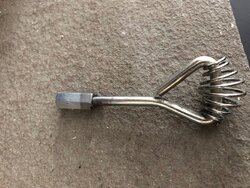
Now I had a removable handle. I threaded a regular 1/4" nut on the rod first then installed the handle. I had marked the rod with nail polish so I could get the orientation of the external handle the same as the internal handle so we could be confident in the damper position. I used the smaller nut as a jam nut to hold it tight. With this setup the handle should not be able to slip out of position.
Here is the final look, I think it came out great.
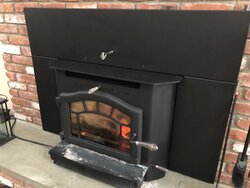
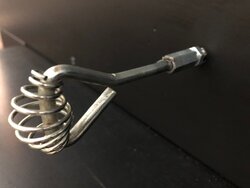
Overall this was pretty easy and really it didnt take long. With this setup I couldnt be more satisfied with this stove!
I installed the damper so the control handle faced the front of the stove. To extend the linkage, I welded some 1/4" threaded rod to the damper handle just long enough to extend about 1" past the surround. I drilled a 1/4" hole in the surround for the linkage to pass through. I used threaded rod so I can easily remove the handle to take off the surround. I welded it together so that I wouldnt have any issue with it falling apart (pardon my welding skills, they are not very good)


I had an extra 6" damper from some old pipe I removed from another stove, so I cut the end of the handle off and welded it to a threaded rod joining nut.

Now I had a removable handle. I threaded a regular 1/4" nut on the rod first then installed the handle. I had marked the rod with nail polish so I could get the orientation of the external handle the same as the internal handle so we could be confident in the damper position. I used the smaller nut as a jam nut to hold it tight. With this setup the handle should not be able to slip out of position.
Here is the final look, I think it came out great.


Overall this was pretty easy and really it didnt take long. With this setup I couldnt be more satisfied with this stove!
weatherguy
Minister of Fire
Pretty clever solution, looks great.The liner for this chimney is 8". I installed the damper on the side of the elbow which connects to the stove, but there were no clearance issues with the liner itself as I tested that as well prior to install. The damper was installed just above the connection to the stove.
I installed the damper so the control handle faced the front of the stove. To extend the linkage, I welded some 1/4" threaded rod to the damper handle just long enough to extend about 1" past the surround. I drilled a 1/4" hole in the surround for the linkage to pass through. I used threaded rod so I can easily remove the handle to take off the surround. I welded it together so that I wouldnt have any issue with it falling apart (pardon my welding skills, they are not very good)
View attachment 240179 View attachment 240180
I had an extra 6" damper from some old pipe I removed from another stove, so I cut the end of the handle off and welded it to a threaded rod joining nut.
View attachment 240181
Now I had a removable handle. I threaded a regular 1/4" nut on the rod first then installed the handle. I had marked the rod with nail polish so I could get the orientation of the external handle the same as the internal handle so we could be confident in the damper position. I used the smaller nut as a jam nut to hold it tight. With this setup the handle should not be able to slip out of position.
Here is the final look, I think it came out great.
View attachment 240182 View attachment 240183
Overall this was pretty easy and really it didnt take long. With this setup I couldnt be more satisfied with this stove!
Similar threads
- Replies
- 14
- Views
- 927
- Replies
- 5
- Views
- 1K
- Replies
- 4
- Views
- 479
- Replies
- 18
- Views
- 576

